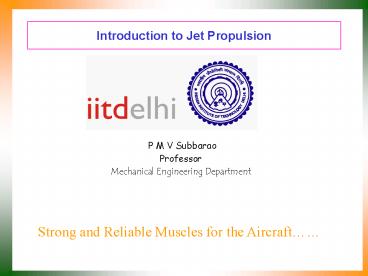Introduction to Jet Propulsion - PowerPoint PPT Presentation
1 / 22
Title:
Introduction to Jet Propulsion
Description:
... Cruising Vehicle Drag on Aircraft Generation of Lift Drag Coefficient of an Air Craft Generation of Lift Drag Coefficient of an Air Craft Lift ... – PowerPoint PPT presentation
Number of Views:210
Avg rating:3.0/5.0
Title: Introduction to Jet Propulsion
1
Introduction to Jet Propulsion
- P M V Subbarao
- Professor
- Mechanical Engineering Department
Strong and Reliable Muscles for the Aircraft
2
Global Momentum Analysis
3
Momentum Equation
Vac
Vjet
pinlet
pexit
Newtons Second Law of Motion
Reynolds Transport Theorem
4
For a frictionless flight, pressure forces are
only the surface forces
Steady state steady flow
5
Pressure Thrust
Momentum Thrust
At design cruising conditions Pressure thrust
is zero.
6
Generation of Thrust The Capacity
Thrust
f Fuel-air ratio
7
Dynamic Equilibrium Cruising Vehicle
For a cruising vehicle
8
Drag on Aircraft
9
Generation of Lift
10
Drag Coefficient of an Air Craft
11
Generation of Lift
12
Drag Coefficient of an Air Craft
13
Lift - to - Drag Ratio
Flight article Scenario L/D ratio
Virgin Atlantic GlobalFlyer Cruise 37
Lockheed U-2 Cruise 28
Rutan Voyager Cruise4 27
Albatross 20
Boeing 747 Cruise 17
Common tern 12
Herring gull 10
Concorde M2 Cruise 7.14
Cessna 150 Cruise 7
Concorde Approach 4.35
House sparrow 4
14
Minimum Drag Coefficients Minimum Drag Coefficients Minimum Drag Coefficients Minimum Drag Coefficients Minimum Drag Coefficients
Aircraft Type Aspect Ratio CDmin
RQ-2 Pioneer Single piston-engine UAV 9.39 0.0600
North American Navion Single piston-engine general aviation 6.20 0.0510
Cessna 172/182 Single piston-engine general aviation 7.40 0.0270
Cessna 310 Twin piston-engine general aviation 7.78 0.0270
Marchetti S-211 Single jet-engine military trainer 5.09 0.0205
Cessna T-37 Twin jet-engine military trainer 6.28 0.0200
Beech 99 Twin turboprop commuter 7.56 0.0270
Cessna 620 Four piston-engine transport 8.93 0.0322
Learjet 24 Twin jet-engine business jet 5.03 0.0216
Lockheed Jetstar Four jet-engine business jet 5.33 0.0126
F-104 Starfighter Single jet-engine fighter 2.45 0.0480
F-4 Phantom II Twin jet-engine fighter 2.83 0.0205 (subsonic) 0.0439 (supersonic)
Lightning Twin jet-engine fighter 2.52 0.0200
Convair 880 Four jet-engine airliner 7.20 0.0240
Douglas DC-8 Four jet-engine airliner 7.79 0.0188
Boeing 747 Four jet-engine airliner 6.98 0.0305
X-15 Hypersonic research plane 2.50 0.0950
15
Propulsive Power or Thrust Power
Measure of compactness of a jet engine
Specific Thrust S
16
Measure of fuel economy
Thrust Specific Fuel Consumption TSFC
17
Aviation Appreciation
Propulsion Efficiency
18
Jet Characteristics
- Quantities defining a jet are
- cross-sectional area
- composition
- velocity.
Of these, only the velocity is a truly
characteristic feature and is of considerable
quantitative significance.
19
Jet Characteristics of Practical Propulsion
Systems
System Jet Velocity (m/s)
Turbofan 200 - 600
Turbojet (sea-level, static) 350 - 600
Turbojet (Mach 2 at 36000 ft) 900 - 1200
Ramjet (Mach 2 at 36000 ft) 900 - 1200
Ramjet (Mach 4 at 36000 ft) 1800 - 2400
Solid Rocket 1500 2600
Liquid Rocket 2000 3500
20
Nozzle Steady State Steady Flow
in
jet
First Law
No heat transfer and no work transfer No Change
in potential energy.
21
Combined analysis of conservation of mass and
first law
A SSSF of gas through variable area duct can
interchange the enthalpy and kinetic energy as
per above equation.
Consider gas as an ideal and calorically perfect.
22
Isentropic expansion of an ideal and calorically
perfect gas.































